This chicken rendang recipe is as good as it gets with its highly aromatic, thick and rich gravy. Rendang ayam is what we call it in Malay and Indonesian.
Estimated reading time: 13 minutes

What is Chicken Rendang?
Chicken rendang is a spicy dry-ish curry. Or you could also call it a stew. Just like beef rendang, this is also cooked slowly in a combination of coconut, highly aromatic herbs and spices. The result is an incredibly seductive curry that speaks to all your senses.
You may have heard me describe it in the past as the pretender to the throne, upon which beef rendang sits majestically. But let me tell you, chicken rendang is in a class of its own.
Like the beef version, it is a popular dish in Singapore, Malaysia, Indonesia and Brunei. It regularly makes an appearance at Eid (Hari Raya in Malay, Hari Lebaran in Indonesian), weddings and other festivities.
What does chicken rendang taste like?
It’s a rich curry that is highly aromatic. It’s creamy, with caramel and toasty flavours. There’s a certain amount of earthiness about it from the ground coriander we use. You also have citrusy and floral notes from the aromatics used.
And lastly, it can be spicy, depending on how much chillies you’ve used.
What’s the difference between Curry and Rendang?
I get this one a lot! Let’s put it this way: all rendang dishes are curries but not all curries are rendang.
Did that confuse the issue?
Basically, rendang is just a type of curry. In terms of identity, it leans towards South East Asian in flavour with a few spices that are used in other cuisines.
You could describe it as a cross between a South Asian curry and a South East Asian one, leaning towards the latter.

How to Cook Chicken Rendang?
Chicken rendang takes much less time to cook then beef rendang, but we still give it the low and slow treatment. And there are a couple of parts to it.
I cook this poultry rendang in a slightly different way from my beef rendang. As mentioned in that article, it’s the way mum made rendang, and taught her by my grandaunt in Ipoh, Malaysia.
In that recipe, we place everything in a saucepan and leave it to simmer, with no initial frying of spices involved. The cooking process works beautifully, because beef rendang has a long cooking time, we’re talking 3-4 hours. This gives the herbs, spices and coconut milk (and kerisik) plenty of time to get it on and do their thing.
But chicken cannot withstand that long a cooking process, and unlike beef, we don’t quite want fallen apart meat here. So, I start off with frying the 3 whole spices I’m using, then the spice paste, before adding the chicken to it.
So half the magic takes place in the initial cooking process of the spices and paste. We fry the paste for 5 minutes, reaching the early pecah minyak stage, but not quite all the way.
I addressed pecah minyak in the Nasi Lemak sambal article. It’s that oil and paste separation stage when frying a spice paste.
Chicken Rendang Recipe
This is what we’ll be doing:
- Soak the chillies.
- Soak the tamarind to get the juice. Read about tamarind here, if you like.
- Make the kerisik (dry fried shredded coconut), more below.
- Make the rempah rendang (rendang spice paste).
- Fry the dry spices, followed by the spice paste.
- Add the chicken, coat, then add everything else and cook for 45 minutes.
How long you end up cooking the rendang depends on the size of your chicken portions. But more of that below.
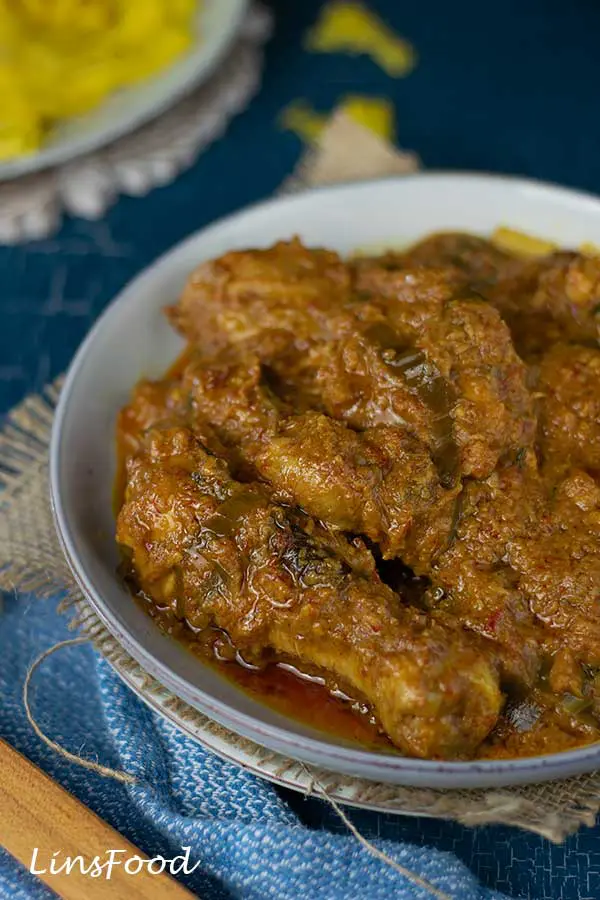
Ingredients
Rendang, like many other recipes from South East Asia, has the odd ingredient that you may struggle to find, depending on where you live. Let’s take a look.
I’m breaking up our ingredients into groups, to get a better idea of what you need and what wants doing.
- Chicken
- Kerisik and Coconut Milk
- Spice paste (rempah)
- Turmeric Leaves
- Spices
Chicken
Traditionally, we’d cook this with a whole chicken, chopped up into its various parts.
But I much prefer buying the equivalent of that in portions, so I get all the “good parts”, so to speak. A mix of various parts of a chicken is the best way to go. Some on the bone, and some, off.
So I’ll have some thighs, chicken breasts, drumsticks and/or chicken legs. Because of the shorter cooking time, a little bone on chicken is quite important in chicken rendang, to add depth and flavour. So at the very least, throw in 3-4 drumsticks.
And unlike beef rendang, we don’t worry about needing to chop up all the chicken into equal portions. You can do so with the boneless chicken parts, but leave the drumsticks and legs as they are.
Skin or no skin? If you have an aversion to chicken skin, then by all means use skinless chicken breasts and chicken thighs. But otherwise, leave the skin on, because, chicken skin coated with that beautifully rich gravy is so incredibly delicious, it’ll make you see stars. Just like this Chinese Saliva Chicken recipe on LinsFood.
Kerisik and Coconut Milk
Kerisik
Kerisik is essentially grated coconut that’s been dry fried. You end up with a dry, crumbly and extremely aromatic product that is an essential part of any rendang recipe. It can be added to the spice paste or added to the curry during the cooking process.
I have an old recipe on my YouTube channel showing you how to make it, but I’ve also included it on this video. It’s a 5-minute job.
In Singapore and Malaysia, I would have access to freshly grated coconut from the local grocers and supermarkets, from which I’d make kerisik and press out the coconut milk needed.
But here in the UK, I tend to use desiccated coconut plus 1-2 Tbsp of coconut milk to replace the flavour lost from the drying process. You could also use the South Asian frozen grated coconut available widely in the UK. But I find that it’s a little too coarse for my liking, and doesn’t brown as evenly.
Coconut Milk
If you have access to freshly grated coconut or fresh coconut milk, then you want the equivalent of 1 whole coconut for the recipe here.
Otherwise, 1 can of coconut that contains 400ml of milk. This would be a 14-ounce can in non metric. Get the best you can find, with as little additives and as much coconut extract as possible.
The organic ones tend to have just coconut and water, with maybe a natural stabiliser included. The stabiliser is not a bad thing as it ensures that your coconut milk will not split during cooking if you happen to have the heat too high.
Spice Paste (Rempah in Malay)
Our chicken rendang spice paste is absolutely crucial in cooking up any rendang. No shop bought rendang paste is going to come anywhere near the homemade version.
If you live in a place where you can buy rendang paste, I bet you can get hold of galangal, that elusive tuber crucial in so much of South East Asian cooking. Let’s take a look at what makes up our rempah.
What’s going to make your job easier here is having an electric food chopper or blender to blend all your spices up.
You could use a pestle and mortar, if you fancy, but it will take quite a while to pound all those ingredients to get your spice paste.
Dried Chillies
Rendang is traditionally a spicy curry and this is as a result of the dried red chillies that we use in the paste. But you’ll be pleased to know that not everyone makes it spicy.
How many chillies you use and the type will influence the heat level of your chicken rendang. If you don’t have access to a variety and only have spicy ones, then you can use as little as just 5 in the recipe below.
The only thing you want to ensure is that you are using non smoky dried chillies. Kashmiri type chillies and what is popularly sold as New Mexico chillies will give you a fairly mild rendang, even if you’re using the full 20 in the recipes.
Mind you, most Kashmiri chillies sold outside Kashmir are not the real thing, so you might want to taste one to see how hot it is first!
Onion, Garlic, Ginger
I’ve grouped this into one, because they’re common ingredients. The only thing worth mentioning are the onions.
Many Asian recipes will call for a combination of red onions and brown, or shallots. But I don’t like cooking with red onions, they’re too sweet and not strong enough, especially in curries.
So I always use brown onions, keeping the red for eating raw and pickling. Speaking of which, I have an amazing pickled red onions recipe here on LinsFood.

Lemongrass
Click here to read more about lemongrass.
Lemongrass is known as serai in Malay, sereh in Indonesian and Dakrai (or takrai) in Thai. It is an incredibly aromatic herb with sharp, citrusy, sweet and pine-like aroma and flavour.
And you absolutely must have it to make rendang. Fresh lemongrass is easily available in most supermarkets in the UK, and the paste is also just as common.
Click on the link below to read up more on lemongrass.
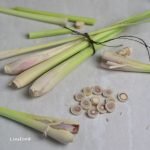
Galangal
Click to read more on galangal. The curry won’t work as well without it, I’m afraid.
Galangal, a natural accompaniment to lemongrass, has a sharp, floral, sweet and almost pine like aroma and flavour. Ginger on the other hand, is citrusy and spicy. In terms of usage, it is a different ingredient altogether from ginger.
Galangal Substitute: absolutely none. Ginger is not a substitute for galangal. No matter what you read and how many times you read it on other food sites.
The good news is, in the UK, galangal paste is easy to come by; it’s sold in larger supermarkets like Waitrose and Sainbury’s. And you know you’ll find it online easily.
1 tsp paste = 1″/2.5cm fresh galangal.
1/2 tsp powder = 1″/2.5cm fresh.
Don’t use too much galangal as it’ll make your chicken rendang overly sweet.
Click on the link below to make your own galangal paste.

Turmeric Leaves
Called daun kunyit in Malay, turmeric leaves are absolutely crucial if you’re going to call your rendang (of whatever inclination) an authentic Singaporean or Malaysian rendang. Like laksa leaves in laksa. Without them, your laksa is just curried noodles!
- daun = leaf, pronounced da – own, but joining the 2 syllables; da as in car
- kunyit = turmeric, pronounced coo – nyate.
The ny is a tough one to explain, and the sound doesn’t exist in the English language. I’ll be doing a show and tell for my YouTube channel this summer (2023) as soon as I have some fresh leaves; they’re still tiny shoots at the moment. I’ll link up here so you can listen to me pronounce kunyit.
Turmeric leaves are probably not something you’ll find outside of Asia. But the good news is they are so, so easy to grow, as long as you have access to the fresh tuber. You’ll probably find it in South Asian grocers, and here in the UK, it’s sold in Waitrose and by Ocado.
Just pot it up in some compost in milder months, or grow it in your garden in the summer. When the temperatures get cold, cut them up and freeze. They’ll last indefinitely in your freezer. This is how I have access to them year round.
Turmeric Leaves Substitute
There are no substitutes for turmeric leaves. However, when cooking rendang, an alternative herb you can use is Kaffir lime leaves. Assuming it’s not as elusive where you are.
If you can’t get either, as a last resort, cook up your chicken rendang then finish it off with some finely chopped fresh coriander leaves (cilantro) and a little zest of any lime.
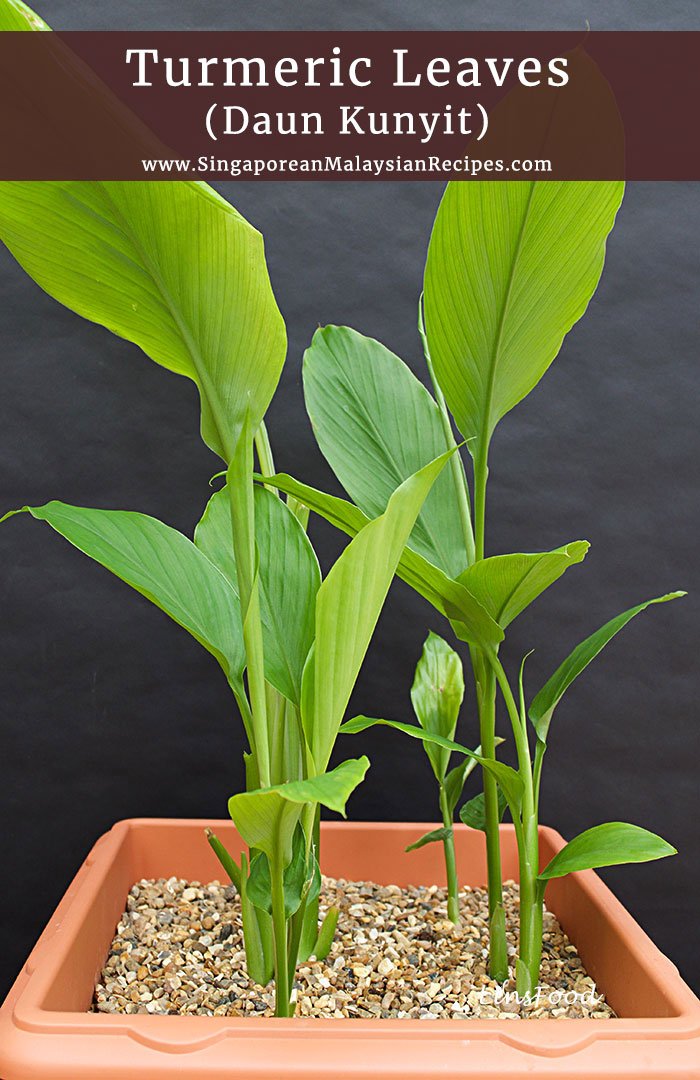
Chicken Rendang Spices
So rendang is a curry, we’ve ascertained. However, what you don’t want to do is swamp it with endless curry spices just because we call it a curry.
I’ve seen rendang spice pastes that have ground cloves, cardamom, cinnamon, coriander, cumin and so on. Let me tell you that that’s just way too many spices for this curry that relies more on the aromatics and coconut than it does the spices.
Using too many ground spices in your rendang paste is going to obscure the beautiful, subtle aromas of galangal and lemongrass.
I tend to use only ground coriander and turmeric (sometimes fresh, sometimes turmeric powder).
So these are the spices I’m using in today’s recipe, the ground ones go in the paste:
- ground turmeric – complements the lemongrass and galangal
- ground coriander – adds earthiness and depth
- whole star anise
- small cinnamon stick
- cardamom
This is more than I use in beef rendang. We come back to the whole point I made above that because chicken rendang has a shorter cooking time, I give its flavours a little nudge. Which brings me to our souring agent, below.
Tamarind
Click here to read more about tamarind, how to use it and for substitutes.
So in my beef rendang, I don’t use tamarind. My granny, mum and aunts never did, so that’s how I’ve always cooked it.
But our chicken rendang benefits from the use of a souring agent. Ordinarily, I’d just throw in a couple of pieces of asam gelugor, aka asam keping. It is the sliced rind of the Garcinia atroviridus fruit.
However, I figured that you guys who don’t live in Asia are probably going to struggle with finding it, so I’m using tamarind instead.
I give you a fairly generous amount, and we start off using half of it. You can then increase it at the end of cooking time, when you’re tasting it to check for salt level.
If you’ve got a jar of it in paste form, the best thing to do is to read the instructions. If they aren’t available, a rough guide is 1 Tbsp of jar paste = 1 Tbsp pulp.

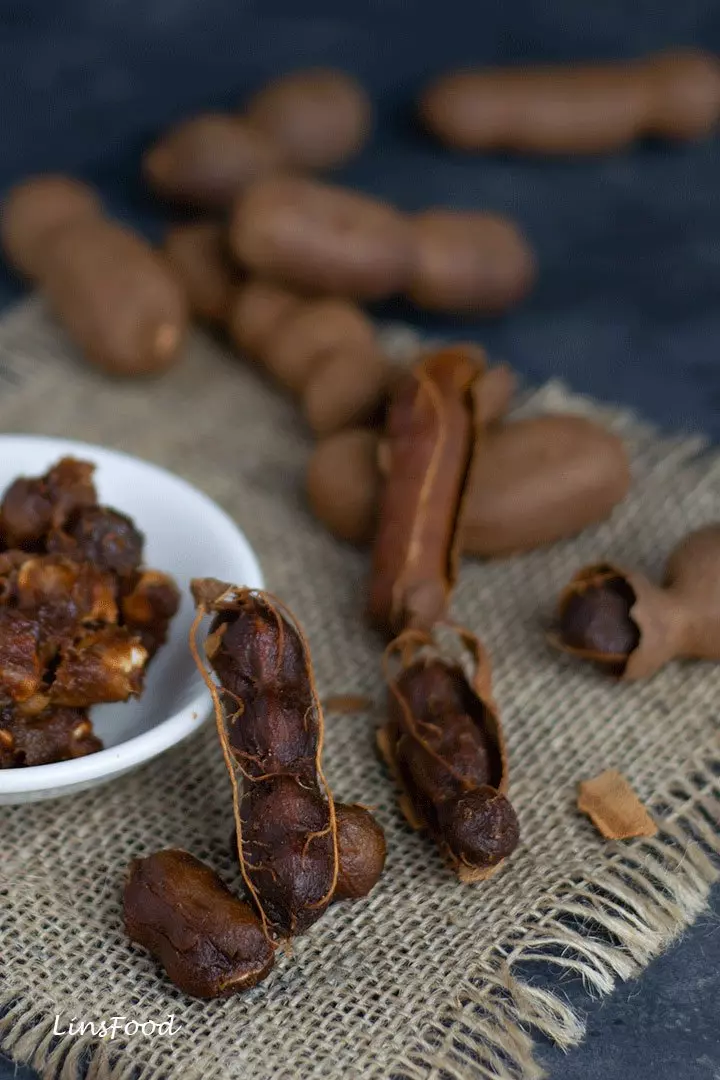
How to Serve Chicken Rendang
Just as you would beef rendang.
Chicken rendang is sold and cooked throughout the year. However, like the beef version, and my vegan rendang (click for recipe), it has a special place on our festive tables.
So while ordinarily, it would be served with some plain white rice, it comes into its own with the following.
- Nasi Minyak
- Lemang
- Roti Jala
A side salad or more traditionally, some acar is the perfect complement. Apologies for not having an acar recipe on this site yet!
Rendang Accompaniments



How Long will it Keep?
Our chicken rendang will keep in the fridge for 3 days, kept in an airtight container.
It also freezes well. To reheat, just add about 60ml/quarter cup water and simmer it gently on the stove, or heat it up in the microwave oven. Be sure to stir it as it’s heating up, a couple of times if you’re doing it in the microwave oven.
If you enjoy the recipe, drop me a comment and let me know. And if you are feeling like a star, don’t forget that 5-star rating! 😉Thank you!
If you make this recipe, post it on Instagram or Facebook and tag me @azlinbloor and hashtag it #linsfood.
Lin xx
More Chicken Curries on SMR
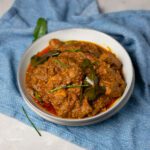
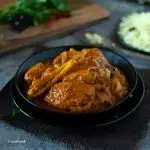
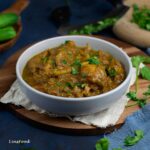
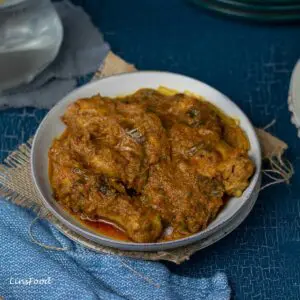
Chicken Rendang Recipe (Resepi Rendang Ayam)
Equipment
- knife
- scissors
- ladles and spoons
- sieve/colander
- bowl
- saucepan or dutch oven
Ingredients
Ingredients A
- 4 Tbsp vegetable oil (minyak)
- 1 kg mix chicken portions see article above
- 400 ml coconut milk (santan)
- 125 ml water (air)
- 1 stalk lemongrass, bruised (serail)
- 2 large turmeric leaves OR 6 kaffir lime leaves (daun kunyit)
- 1 tsp salt (garam)
Tamarind
- 3 heaped Tbsp tamarind pulp (asam jawa) or 2-3 Tbsp shop bought paste
- 125 ml water for the tamarind
Kerisik
- 4 Tbsp desiccated coconut or grated coconut
- 1 Tbsp coconut milk (from above)
Dry Spices
- 1 star anise (bunga lawang)
- 1 small cinnamon stick (kayu manis)
- 3 green cardamom pods (buah pelaga)
Ingredients B (Spice Paste, Rempah)
- 3 stalks lemongrass (serai)
- 2.5 cm galangal (lengkuas)
- 5 cm ginger (halia)
- 5 medium cloves garlic (bawang putih)
- 20 dried red chillies (cili kering) see article above
- 2 large onions, quartered (bawang besar)
- ½ tsp ground turmeric (serbuk kunyit)
- 1 Tbsp ground coriander (serbuk ketumbar)
Instructions
Prep Work
- Put the kettle on, about half full.Dried Chillies. Cut the dried red chillies in 2-3 pieces, depending on their lengths, and soak them in a bowl of hot water for 20 minutes. In the meantime, get all the other ingredients ready.After 20 minutes, drain and rinse the chillies, and losing the seeds, if you like. Place them aside.
- Tamarind. Place the tamarind pulp (if using) into a bowl, and top with 125 ml (½ cup) of hot water from the kettle. Leave to soak for 10 minutes, no need to cover.
- At the end of 10 minutes, mash it all up with your fingers and fish out all the fibrous pulp and bits of shell, as much as you can.I prefer not to strain the tamarind juice, as you'll miss out on all the flavour if you do. The odd bit of pulp is perfectly fine.
- Roll your turmeric leaves up and either using a knife or a pair of scissors, cut them up into thin shreds.If using lime leaves, just tear the leaves up.
Kerisik
- Shake your coconut can up to mix the fat and liquid into 1 homogenous mixture.Tip the desiccated coconut into a small frying pan, along with 1 Tbsp of the coconut milk. Cook on low for 2-3 minutes, tossing the flakes until they are dry and a deep golden brown colour.Err on the side of caution and take it off before they get too brown, as towards the end, they can burn pretty quickly.
- Tip it out onto a plate or your mortar. This will stop the kerisik from burning in the hot pan.Leave to cool for 5 minutes, then pound to a semi-coarse grind.
Let's chop up the ingredients into a paste
- Place your lemongrass, galangal, ginger and garlic and chop for 20 seconds.Add the chillies and chop again for 20 seconds.Now add the onions and blend everything to a fine paste.
- Finally add the ground turmeric and coriander and blend in.
Let's get cooking!
- Heat the oil on medium and fry the star anise, cinnamon and cardamom for 20 seconds.
- Add the bruised lemongrass and spice paste and fry for 5 minutes, stirring every so often. Because we're only using 4 Tbsp of oil, it will start to get dry half way through. Just turn the heat down to medium-low and stir to stop it from burning.
- At the end of 5 minutes, tip in the chicken pieces and coat them well with the spice paste. Stir and leave the chicken to cook for 1 minute.
- Add half the tamarind juice, coconut milk, water, turmeric leaves and kerisik, and bring everything to a simmer on medium heat. Give it a good stir.Cook, uncovered, for 45 minutes, stirring a few times in the last 15 minutes.If you're using bite-sized boneless chicken, then you only need 30 minutes.
- When it's done, check seasoning and add more salt if you think it needs it. And also more tamarind to your taste, if you fancy a little more tartness and depth.Just bear in mind, rendang is not a tangy curry, and you are not going for hot, sweet and tangy Thai flavours.Serve as suggested in the article.

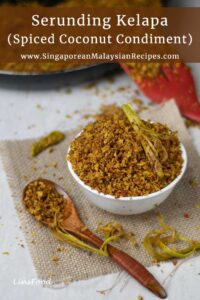
6 thoughts on “Chicken Rendang Recipe (Resepi Rendang Ayam)”